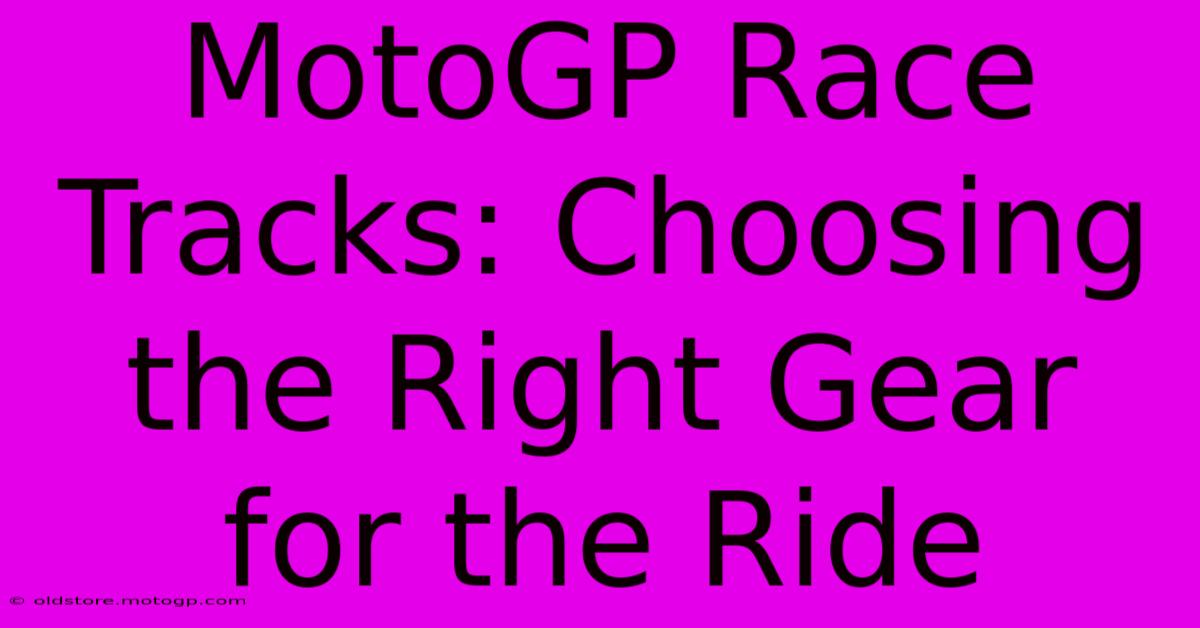MotoGP Race Tracks: Choosing The Right Gear For The Ride

Table of Contents
MotoGP Race Tracks: Choosing the Right Gear for the Ride
MotoGP races are thrilling spectacles of speed, skill, and precision. While we might not be competing alongside Marquez or Bagnaia, many of us experience the thrill vicariously, attending races or dreaming of our own laps around iconic circuits like Assen or Mugello. But even attending a MotoGP race, or riding your own bike inspired by these legends, requires the right gear. Choosing the correct riding attire is crucial for safety and comfort, no matter your skill level or the track. This guide will help you choose the appropriate gear for a MotoGP experience.
Understanding the MotoGP Track Environment
Before diving into specific gear, let's consider the unique environment of a MotoGP track. These aren't your average roads. High speeds, abrupt changes in direction, and potentially abrasive surfaces demand protective equipment beyond what's needed for street riding. Factors to consider include:
- High Speeds: MotoGP bikes reach incredible speeds. Your gear needs to withstand the impact forces involved in a potential fall.
- Abrasion: Slides on asphalt are a real possibility. Your gear needs to resist abrasion and tearing to protect your skin.
- Impact Protection: Falls can result in significant impacts. Protection for your head, body, and limbs is essential.
- Weather Conditions: Races happen in diverse climates. Be prepared for everything from scorching sun to torrential rain.
Essential Gear for MotoGP Spectators & Track Day Enthusiasts
Whether you're attending a race or participating in a track day, appropriate gear is paramount.
1. Helmet: The Cornerstone of Safety
A high-quality helmet is non-negotiable. Look for helmets meeting or exceeding ECE 22.05 or DOT standards. Features to consider include:
- Full-face Design: Provides maximum protection for your head and face.
- Lightweight Construction: Reduces neck strain during long periods of wear.
- Effective Ventilation: Keeps you cool and comfortable, especially in hot conditions.
- Clear or tinted Visor: Choose according to the weather conditions.
2. Protective Jacket & Pants: Shielding Your Body
Your riding jacket and pants should offer abrasion resistance and impact protection. Look for gear constructed from durable materials like leather or abrasion-resistant textiles (Kevlar, Cordura).
- Armor: Reinforcements at elbows, shoulders, knees, and hips are crucial for impact protection.
- Fit: The jacket and pants should fit snugly but not restrictively, allowing for freedom of movement.
3. Gloves: Dexterity and Protection
Riding gloves offer protection for your hands, improving grip and dexterity. Features to prioritize include:
- Reinforced Palms and Fingers: Reduces the risk of injury in a fall.
- Impact Protection: Knuckle protection is essential.
- Good Grip: Ensures secure control of your bike, particularly when braking or accelerating.
4. Boots: Ankle and Foot Support
Motorcycle boots offer ankle support and protection. Choose boots that cover your ankles and offer good protection around the toes, heels and shins.
- Reinforced construction: Essential for protection in the event of a fall.
- Ankle support: Provides stability and reduces the risk of ankle injuries.
- Non-slip soles: Provides better grip on the foot pegs.
Gear for Different Levels of Participation
The level of riding determines the type and quality of gear needed.
Spectators:
For spectators, comfortable yet protective clothing is essential. Sturdy shoes, long pants, and a jacket will provide some protection from debris, sun, or unexpected changes in weather. A hat and sunglasses are helpful additions for protection from the sun.
Track Day Riders:
Track day riders need far more protection. Invest in high-quality gear meeting or exceeding relevant safety standards (CE or equivalent). This includes full leather suits, reinforced gloves and boots, back protectors, and neck braces if needed.
Professional Riders:
Professional riders use the most advanced and technologically superior equipment, engineered for maximum safety and performance. This equipment is typically bespoke, tailored to the rider’s individual needs.
Maintaining Your Gear
Regardless of the type of gear, proper maintenance is vital. Regular cleaning and care will extend its lifespan and maintain its protective capabilities. Always refer to the manufacturer's instructions for cleaning and care.
By choosing the appropriate gear for your level of participation and the environment, you can significantly enhance your safety and enjoyment at a MotoGP race or track day. Remember, safety is paramount – don't compromise on your protective equipment.

Thank you for visiting our website wich cover about MotoGP Race Tracks: Choosing The Right Gear For The Ride. We hope the information provided has been useful to you. Feel free to contact us if you have any questions or need further assistance. See you next time and dont miss to bookmark.
Featured Posts
-
The Best Moto Gp Pictures Of The Year
Feb 24, 2025
-
Cota Open Track Days Where Legends Are Made
Feb 24, 2025
-
Houstons Premier F1 Event Be There
Feb 24, 2025
-
Moto 2 Specs The Future Of Motorcycle Racing
Feb 24, 2025
-
Austin F1 Qualifying For The Checkered Flag
Feb 24, 2025
